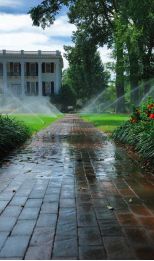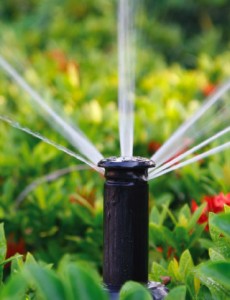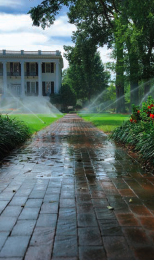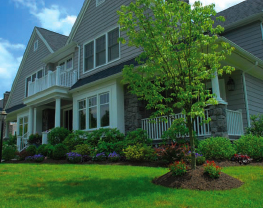LUSH LAWNS Trends in Irrigation

 Lawn irrigation systems are not just about creating a beautiful yard. Water conservation and the environment are forefront in the minds of landscapers and irrigation companies today. That means fabulous floribunda without a drop of water or moment of time wasted.
Lawn irrigation systems are not just about creating a beautiful yard. Water conservation and the environment are forefront in the minds of landscapers and irrigation companies today. That means fabulous floribunda without a drop of water or moment of time wasted.
“Everything that we are doing right now is based on conservation and intelligent irrigation. It is based on making water irrigation more efficient,” says Joe Johnston, president of Rain Maker Irrigation, Inc.
Technology delivers on both conservation fronts with sensors, pre-programmed systems and automated sprinklers.
Starting at the top are the systems familiar to anyone who lives on the greens. These smart controllers are now available to everyday consumers. Details about the soil, moisture levels, plant material, slope, shade and sun exposure are compared to satellite weather forecasts. That determines when and how much the system will water, without the homeowner lifting a finger. The system costs several hundreds of dollars, not including a monthly subscription fee for the satellite weather information.
If that sounds like too much, a rain sensor is a great place to start. More and more cities in Virginia are giving residents incentives to install them because of the water savings they foster. The device is placed in an open space where it collects falling rainwater. Once a set amount of water is collected, it triggers the sprinkler system to shut down. Such a sensor will run anywhere from $60 to $200.
The drip irrigation system is an excellent option if you are trying to keep flowers and shrubs thriving. Morris Johnson, president of Westlake Turf & Irrigation, says they are now well worth the effort, despite the fact that they are labor-intensive to install. “Drip irrigation is coming into its own,” he says. “It conserves a tremendous amount of water.” The system consists of a long tube beneath shrubs and flowering plants so that water is delivered directly to the roots. It isn’t feasible for lawns or large areas, but it is ideal for mulched areas and potted gardens. For a potted garden, drip lines radiate out from the main line into each pot.
 Bells and Whistles
Bells and Whistles
Landscapers are also working on eliminating waste and pollution.Common to big industries, backflow devices are now being placed on everyday irrigation systems. In fact, they are becoming a requirement in many cities. When a water line breaks, the device keeps the yard water, often laced with fertilizer, from backing up to mix with potable water.
Another favorite that helps prevent wasted money is the sewage subtraction meter. Although the upfront cost is several hundred dollars including installation, you will recoup that cost many times over. It prevents homeowners from being charged sewage fees on the water used for irrigation. Those who water their yards with hoses or handheld sprinklers are not eligible for the same savings.
Saving you time is what the latest fertilizing attachment does. The fertilizer tank is attached to the sprinkler waterline beneath the ground. Water passes through the tank filled with fertilizer (either liquid or granular), picks up the fertilizer, then spreads it over the lawn or shrubs. The fertilizer tank is refilled every three to four months, and can even be added to an existing system. It will increase the cost of your irrigation system by about 20 percent.
 Watering Know-How
Watering Know-How
Before programming your irrigation system, remember that lawns need more water than plants and shrubs.
If you keep the grass short, it will have shallow roots and need more irrigation. Taller grass, say three to four inches long, needs less irrigation. The longer grass gives more shade, and more shade means the water won’t evaporate as quickly and the roots can grow deeper.
Robert Spangler, irrigation division manager for M & M Grounds, Inc. says, “When the temperature is over 90 degrees, you need to cool the grass by watering for short periods of time throughout the day.” Your plants, he says, will be fine without the shower.
You always want to water before sunrise so the water has enough time to be absorbed. Watering in the evening leaves the lawn vulnerable to diseases and fungus. The same can happen if you water too much. You will also end up wasting that pricey fertilizer and damaging the soil.
You’ll know something is amuck with your watering schedule, or system, when you see brown spots, or feel hard and dry spots, or soft and wet spots. If that happens, turn the system on and see if all of the sprinkler heads rise out of the ground and spray uniformly. If there is a leak, the heads won’t come up completely.
If something does break, call the installer before your plants and lawn are damaged. Some landscape companies guarantee not only their work but also your plants if you have an irrigation system installed to care for them.
With the right equipment and a little watering know-how, your lawn will be lush all summer long.






